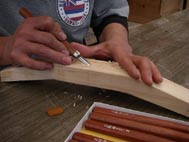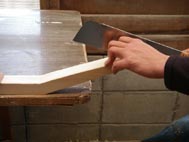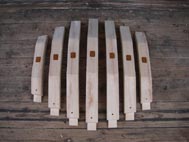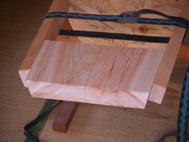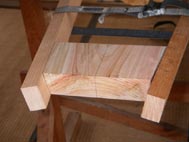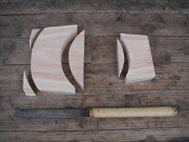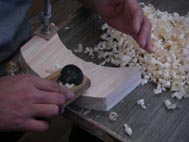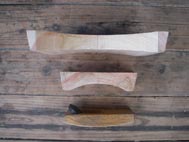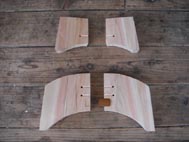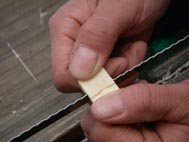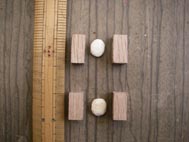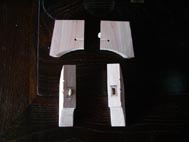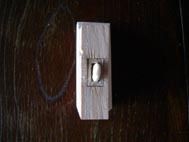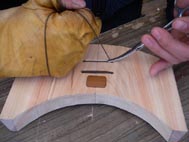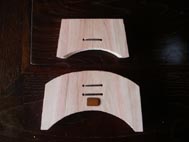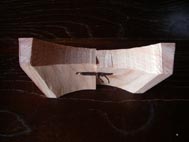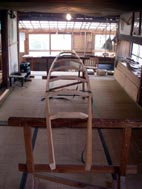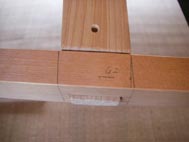
2007年3月5日 ビームの加工 その3
Processing deck beam 3
切り出したビームを、ノミやナイフを使い形を整える(写真1)。次にビーム上部中央に、デッキストリンガーとの接触を緩衝する材を(写真2)埋め込む。本来は動物の骨を使うが、僕は古竹を代用としている(写真3、4)。ホゾ挽きをし、ビーム両端に、ガンネルと結び合わせるための穴を開け、仕上がったビーム(写真5、6)。
The beam wood which cut out by saw or hatchet must be finish by using a knife or a chisel (photo1). Next , bury the buffer material which works between the deck beam and the deck stringer (photo2).
Originally bone of animals is ideal material, but I use a small piece of old bamboo (photo3,4).
Finishing tenon work by using saw (photo5), and make holes on both (left and right) tip of the beam to lash up with gunwale, then deck beams are ready to assemble (photo6).

|
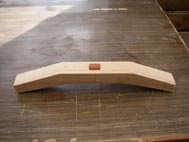
|
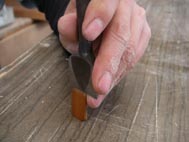
|
写真1. ビームの裏面を仕上げているところだが、ひたすら根気よく!
Finishing the downside of the beam with a chisel and disciplined patience. |
写真2. このあたりの構造が、バイダルカの特質の一つだ。
This figure of the deck beam shows well a character of Baidarka. |
写真3. 古竹の厚みを整える。
Working for a buffer material bamboo by using chisel. |
|
|
|
写真4. 彫刻刀などを使い、緩衝材を埋め込む凹みを作る。
By using a curving knife, making a hollow on upside of beam to bury a buffer bamboo. |
写真5. 胴付きノコでホゾを切る。
Tenon work by using a saw. |
写真6. 穴の回りはささくれなど無いように仕上げる。雑な仕上げをすると糸が切れる。
Clear finishing will be required. Rough wood work will cut strings for lashing. |
手道具は静かに黙々と働く。胴付きノコを使う時、ノコ刃の重みだけで挽く。
余分な力が加わり刃が捩じれると、あさりが開き、ノコはかすかにうめき声を上げる。「挽き目が曲がったぞ」と控えめに話しかけてくる。
以前は手打ちの胴付きノコを使っていたが、僕の腕にはとても負えない。あさりが開く度に目直しにだす。今の日本に胴付きノコの目立てができる職人が何人いるんだろうか?
繊細な仕事をするには繊細な道具がいる。道具の発達には分業による職人の熟練がいる。古いアリュートの世界にも分業があっただろうと想像する。
I work with hand tools gently and quietly.
Especially saw working. When I work just by extra force, it groans just like talk to me modestly “hey, you are going wrong way !”. You have to pull ( in Japan, a saw is always pull, never push) a saw just by the weight of their blade.
I used to use a nice hand-forged traditional saw. But I gave up! Because I was tired to look for a good saw-set craft man every time I spoil the edge of my saw.
We need a delicate tool to work delicately. For the development of tool, division working of well-trained craft man is necessary.
I wonder how Aleutian builder was working with their delicate craft.

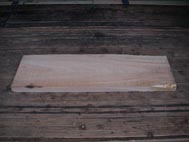
写真1. この材は長さ約85cm、幅30cm、厚み4cm。
例えば、バウエンドピースは最終的に長さ9cm、
幅16cm・14cm、厚み3cmの台形に加工するが、
単純に9×16×3cmの材を使えば良い訳ではない。
必要なのはその部材に相応しい木目の材だ。
Since the working have to be done along grain
of wood, you need to get a big enough material
with some margin.
2007年3月10日 バウ・スターンエンドピースの加工 その1
Processing of bow / stern end piece
2本のガンネルの先端部を結合する、バウとスターンのエンドピースを加工する。檜の板目材(写真1)から、部材を切り出し、ガンネルの両先端に置く(写真2、3)。木目を吟味し、相応しい部位を選び、ビーム加工と同じ方法でサイズを計り線引きする。
次にガンネルと接する部分をノコ挽きする(写真4)。寸分違わず、ぴたりと収まったスターンエンドピース(写真5)。バウエンドピース(写真6)の写真右側、わずか1mm程度だが隙間がある。これは右側のガンネルのバウトップの捩じれを、組み上げる段階で調整するためだ。
さらにそれぞれの余分な部分を挽き落とし(写真7)、裏面を凹ませるため削る(写真8、9)。2分割に挽き、結び合わせるための穴を開け、糸道を付けた。バウエンドピースには、ビームと同様に緩衝材を付ける。
Here, we go into the process of bow and stern end piece which assemble with two gunwale tips. Cutting out pieces from cypress plank (cross grain, photo1), and put them on the both tip of gunwales( photo2,3). Again , it is important to work along grain of wood.
Then saw the piece to fit to gunwales( photo4,5). I made a small gap on purpose in order to adjust a small torsion of gunwales( photo6).
Then some more saw work, and correct form of pieces appears( photo7). Shaping the down side of the piece to make a ideal hollow( photo8,9). Then saw them half and make holes for lashing.
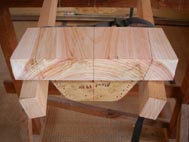
|

|
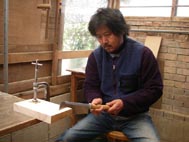
|
写真2. バウエンドピース材。木目を良くご覧頂きたい。
A plank for bow end piece. See the grain of wood. |
写真3. スターンエンドピース材。
A plank for stern end piece. |
写真4. 胴付きノコで慎重に丁寧にゆっくり挽く。
Working with a saw gently again. |
|
|
|
写真5. サイズは約長さ12cm、幅21cm・23cm、厚み3cm。
Approximate size of a stern piece is, length 12cm, width 21~23cm, 3cm thick. |
写真6. サイズは写真1.のキャプションを参照。
Size of a bow piece. Length 9cm, width 14~16cm, 3cm thickness. |
写真7. 廻し挽きノコを使った。
Now you see correct form of pieces. |
|
|
|
写真8、9 四方反り鉋を使った。
Shaping down side of a piece.A round bend plane is a perfect tool for this. |
写真10. 胴付きノコで挽き、細かい細工は彫刻刀を使った。
Finishing by using a saw, and curving knife . |
ノコで罫書通りに挽くのは、つくづく難しいと思う。上手に胴付きノコが扱えれば、鉋などで整える必要もない。しかしこれがなかなかできない。心がざわついていてはできない。
アラスカ・ネイティブ・へリテージ・センター発行のQAYAQS & CANOESと言う書籍がある。カヤック職人Gregor Welptonが紹介されている。
僕は1993年に、彼から1ヶ月に渡り、伝統的なカヤック作りの手ほどきを受けた。受けたと言っても、僕は彼の働く姿をじっと見ていただけだった。
以下は僕と彼が実際に交わした会話だ。
「カヤックはどうすれば作れるか?」「木と話せ!木がお前の魂の内側に入り込み、やがてお前の手からカヤックとして生まれる。」
「バイダルカは?」「人生の伴侶と仲睦まじく愛し合え、満ち足りた食事ができ、健やかな眠りがあり、爽やかな目覚めが来た時に作れ!」
If I could handle a saw perfectly, I can through my planes away !
But it is not easy !
I always take a delicate balance between concentration and relaxation when I use a saw. Sometime I can handle myself ,but ・・・・・・.
A traditional kayak builder Gregor Welpton is being introduced in a book titled “ QAYAQS and CANOESAlaskan native heritage center publication”
In 1993, I’d had precious 1 month lecture of northern traditional kayak building from him. Lecture? I mean, I was just watching him working silently.
During our session, we made some conversation.
“How can I build a kayak, how can I be a traditional kayak builder, Mr. Welpton ?”
“ Just take listen to what wood talk to you !
Those words will soak deep into your soul.
And some day, a kayak will be borne from your hands.”
“So how about Baidarka ?”
“Love your partner happily, enjoy meal and get full, sleep tight, and when you get refreshingly wake-up in a morning, it is the time to work for a Baidarka.”

2007年3月12日 バウ・スターンエンドピースの加工 その2 Processing bow and stern end piece 2
樫、楢などの堅い木(写真1)で緩衝材の受け部を作る。厚さ1cm、幅2cm、高さ1cmの長方形を4個線引く(写真2)。それぞれに緩衝材が収まるように凹みを掘る(写真3)。
緩衝材となる骨を所定の大きさに切る(写真4)。やすりなどで楕円形に整え(写真5)、先の樫の受け部にすっぽりと収まるようにする(写真6)。
2分割にされた、バウ、スターンエンドピースに受け部が収まるように、ノミで凹みを掘り、それぞれを収め(写真7、8)、切り離された材を結び合わせる(写真9)。
切り離した部分が分からないほど、ピタリと合っている(写真10)、が動く(写真11)。
このような、動物の関節にもにたフレーム構造が、アリュートの作るバイダルカの特徴であり、知恵の結実とも思う。
Making some small piece which fit the buffer.
Hard wood as oak is suitable( photo1). Size of each piece is, 1cm thick, width 2cm, height 1cm( photo2). Before cutting out pieces from a plank , digging the hollow to fit the buffer material has to be done first( photo3).
Cutting a piece of bone, the buffer material( photo4). Using a file for trimming( photo5), and fitting to the hollow of a oak piece(photo6).
Digging the hollow by a chisel, in bow and stern pieces in order to fit these buffer parts( photo7,8). And tie the both side of pieces( photo9).
Both side of pieces are perfectly fitting( photo10), and they move!( photo11)
This construction which resembles animal’s junction work characterizes Baidarka, a fruits of Aleut’s skill and wisdom.
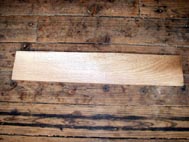
|
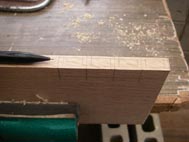
|
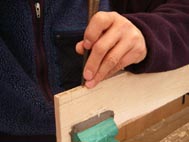
|
写真1. 白樫は重く堅い。山から運び出した時の事を思いだすと、額に汗がにじむ。
White oak is heavy and hard. I remember a day I hump a white oak log down the mountain. Such a sweaty job! |
写真2. くどいようだが、数値は参考までに。
I showed some numerical value above, but you must not insist on it. |
写真3. ノミをこねると刃先は欠ける。
Don’t knead the edge of a chisel ! This high-carbon blade is very delicate. |
|
|
|
写真4. ある程度の大きさに割り、鉄切りノコで整える。
I am trimming a bone piece by an iron-cutting saw. |
写真5. 骨を削る匂いは、僕らの一般的な日常には無い。
Anyone loves this smell ? Just imagine. |
写真6. それぞれのサイズが分かるよう、定規を添えている。
A ruler is showing size of each parts. |
|
|
|
写真7.8. エンドピースに受け部と緩衝材を収めたところ。
This is how a buffer part fit in an end piece. |
写真9. 鉗子などを使い、糸が緩まないように結ぶ。
Tying with some essential item’s help. A glove, and a medical clip.
|
|
|
|
写真10.11. 早く、簡単。電動工具に頼っていてはこのようには作れない。
Quick and neat work without using any power tool. |
|
バイダルカについて語られるとき、その特徴的な二股に分かれた船首が取り上げられる。唯一バイダルカの特徴のように語られ、様々な憶測や見解があるようだ。が、しかしその大部分は、見ためからの推測だったり、他者の考えの借用だったりにしか思えない。
船首の構造はその制作過程で詳しく触れるが、「伝える」「知る」とはどのような行為なのだろうか?文字や言葉だけが事実を伝えているのだろうか?
僕はバイダルカの作り方はバイダルカに直接聞いている。バイダルカは古いアリュートが残した、文字や言葉以上に明確な言語だと捉えている。
僕は「知る」とは、眼前の事象を文字や言葉を媒体とせず、直接飲み込む事だと感じている。ゆるく流れる時の中でバイダルカと過ごせば、バイダルカは自分の生い立ちを見せてくれる。
古いアリュートの人々は、そんな風にラッコやアザラシと共生したのだろう。だからバイダルカのようなカヤックが作れたと、僕の血の記憶は言っている。
So many scholar and builder tells about a distinguishing bow shape of Baidarka. There seem to be a lot of opinion or speculation about that.
I will tell the detail of construction of bow later. But I am always wondering
if we could reach the truth just by words which be said, be written ?
I ask a Baidarka himself how I should work. Because I believe that he is a fruits of Aleutian knowledge and wisdom. Aleutian tribes did not leave anyliteral relics ?Wait a minute ! Why can’t we take listen to a Baidarka himself begins to tell a story ?
Of course, a Baidarka is not only a fruits of human history and activity. It is also a fruits of animal’s life and harsh environment of north.
So Baidarka building is a long trip to go back deep into memories of our own DNA.

2007年3月15日 糸や紐の話
Talkin’ about strings and lines for lashing
バイダルカを作るにあたり大切な素材の一つとして、フレームを結び合わせる糸や紐、スキンを張る紐、縫い合わせる糸がある。
まずは古いアリュートの人々がどのような糸や紐を使ったか(写真1)。ヒゲ鯨のヒゲ、海洋動物などの筋から作った糸、あるいは皮を細く切った紐などだ。
写真1の上はカリブーの背中から取った筋だ。肉から削ぎ、しごき、天日で乾燥させる。後、ほぐし、適当な太さに裂き分け、撚って糸にする。長さは通常そのまま使う。長く撚り合わせると、糸が切れた時、縫い合わせた部分のダメージが大きくなる。
この糸の特徴は、油分があり水を含みにくい事、乾燥させた状態で縫い、湿気を吸うと糸が膨張し、針穴をつぶし、縫い目の防水性を高める事だ。
僕はフレームを結び合わせる糸、スキンを張る糸は、ナイロン糸に油分をしみ込ませたものを使う(写真2)。スキンを縫う糸はワックス仕上げのラミン糸か、人工的に作られたナイロンの筋を使っている(写真3)。
様々な糸や紐を試してきたが、滑らず、伸縮がある糸や紐がバイダルカには向いているようだ。
We assemble flames and parts by lashing instead of using iron nails or screws.
So strings or lines will be very important materials for building a Baidarka. Some for lashing the flame work, and some for stretching and sewing the skin coverings.
I think about what material had been used by Aleutian builder.
Natural fiber which comes from land mammals and sea mammals. And shredded leathers were possible materials.
Fiber material which made of sinew must have been most common material in the history of many hunting culture. Photo 1 shows a chank of caribou sinew. It is broken up, and yarned, then be a perfect fiber for sewing or lashing. Since it contains some oil naturally, and it expands when absorb some water inside. So ancient kayak builders were happy using this sinew strings in order to make their seam water tight.
Only one disadvantage is that you can’t make a long string with it.
I use oil coated nylon string( photo2) for lashing flame work.
And waxed lamin string or the artificial sinew( photo3, it is made of nylon)for sewing the skin covering.
I have tested many kind of strings and lines. I have found out that flexible and non-slipping strings is suitable for building Baidarka.
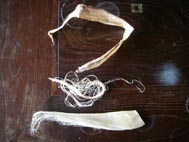
|

|
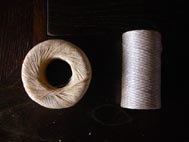
|
写真1. 上、肉からはぎ取り乾燥させた筋。中、ほぐされた筋。下、ヒゲ鯨のヒゲ。
Above, caribou sinew.Center, caribou sinew after being shredded.Below, baleen.
|
写真2. 用途に合わせ、糸の太さ、撚りの具合を使い分けている。
I change the strings to suit the purpose. |
写真3. 左がラミン糸。右がナイロンの筋
Left, waxed lamin strings. Right, artificial sinew( made of nylon fiber). |
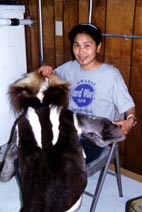 写真1のカリブーの筋はアラスカ北極圏から持ち帰った。コッツビュー湾沿岸の小さな集落デーリングで暮らす、イヌピアックの家族から分けてもらった。 写真1のカリブーの筋はアラスカ北極圏から持ち帰った。コッツビュー湾沿岸の小さな集落デーリングで暮らす、イヌピアックの家族から分けてもらった。
13、4才の息子がカリブーを狩猟し、父親が捌き、母親が筋を取ってくれた。彼ら家族は伝統的な暮らしに近い、キャンプと狩猟で生計を建てているが、子どもの教育のため、今はデーリングの集落に居る。
母親にデーリングの暮らしと、ツンドラでのキャンプの暮らしとどちらが好みか尋ねた。「村の暮らしは人が多すぎる。また、お金がなければ生活できない。ツンドラは静かだ。食べ物も、薬も、衣類も、総てツンドラが分け与えてくれる。私はツンドラの暮らしが好きだ。」
わずか100mも歩けば、集落の外へ出てしまう、人口100人のデーリングでの事だ。彼女が家族のために仕立てた伝統的な衣類は、丁寧に、本当に細かい縫い目だった。 彼女(Agnes Hailstone)の作品は博物館などで見る事ができる。
I brought back some caribou sinew from my trip to Alaska. It came from a Inupiaq family who living in a small village Dealing, coast of the gulf Cotsbue. The family is living by very traditional manner, but for a reason of the education for kids, they have to live in a town of Dealing.
I asked to their mother which she prefer to live, a town or a traditional camp in tundra.
“So many people in town, and we can’t make living without money in here.
We can live in tundra quietly. Nature gives us all. Food, medicines, clothes・・・. That’s why I love living in tundra.” Even in this population 100, 100yard length broad way small town.
A mother, Agnes Hailstone makes traditional costume for her family. I saw her working closely, and amazed her careful, slow work.
You can see her work at museums in Alaska.

2007年3月27日 ガンネルとビーム、その他の組上げ その1
Assembling gunwales and beams 1
仮組したガンネルをばらし、2本を揃えて固定し、下部へリブフレームを収める穴をドリルなどで開ける(写真1)。間隔は手のひら幅程度(写真2)、それぞれのビームの下には必ず穴を開ける事。
次にガンネルの加工その2、ビームの加工その1で説明した、ホゾ位置にホゾ穴を切る(写真3)。ガンネルにビームを組上げた(写真4)状態(写真5)。
建具のようにピッタリとホゾを組んではいけない。波の上で船体が捩じれたとき、ガンネルが割れてしまう。かと言ってすぐ外れるようでもまずい。
固定しているが、遊びがあるホゾ組が好ましい。
Once two gunwales have been assembled with station-boards and belts. But now you get ready to make holes on a down side of gunwales for fixing rib flames( photo1). An interval of each hole is about the width of your palm( photo2). And it is important to make holes just under each deck beam.
Then cutting mortises on gunwales( photo3).
Even if you were an experienced carpenter, never put a mortise to a tenon tightly. It will be a cause to make a serious crack on gunwales. But even if it would be your first Baidarka building, don’t put them too loose. Because this cross section has to “move” depending on the sea condition.
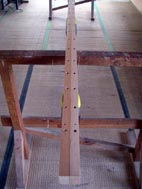
|
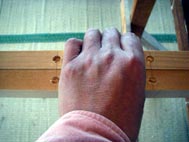
|
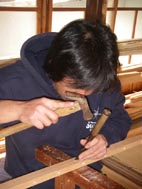
|
写真1. 直径8mm、深さ1cmの穴を44個開けた。
I drilled 44 holes on gunwales. A diameter 8mm, a depth 10mm.
mortise of gunwale and a tenon of deck beam must set not too tight, not too loose. But gunwale and a deck beam must set without any gap.
|
写真2. 数値で言うと約10cm前後。
An interval is about 10cm. The width of my palm. |
写真3. 今回はノミを使ったが、古いアリュートの人々はドリルとナイフでホゾ穴を切った。
Cutting a mortise for a deck beam tenon. I used a hummer and a chisel, but Aleutian builder must have used a hand-drill and a small knife. |
|
|
|
| 写真4. ガンネルの中央部からビームを収めてゆく。
Setting deck beams. Do this starting from center of a deck to fore and rear. |
写真5. ホゾには多少遊びがあるが、ガンネルとビームはピタリと合わせる。
As I wrote above, a mortise of gunwale and a tenon of deck beam must set not too tight, not too loose. But gunwale and a deck beam must set without any gap. |
|
この制作記録では、古いアリュートの方法と、我々の手道具を使う方法とを紹介している。アリュートの伝統的な技術もさる事ながら、日本の伝統的な技術はどうなのだろうか?電動工具を多用し手早く作る事が本当に効率的なのだろうか?確かに制作の時間は短縮できるが、出来上がった物の寿命はどうだろうか?
手入れの悪い電動カンナで木を削る。形は整うが、木肌はささくれる。またはサンディングする。一見表面はつるつるだが、木肌は呼吸しづらくなる。さらに樹脂など塗装し、呼吸を奪う。
樹脂が木肌に密着している間は良いが、いずれ一部が剥がれ、そこから水を吸う。樹脂で覆われているから、吸収した水分が抜けない。木が死ぬ速度を早めているだけにしか思えない。
良く研いだナイフで木を削る。形は画一的には整わないが、木肌は呼吸できる状態に仕上がる。
木は切り倒された後も呼吸する。木の天寿を全うさせる、その術を身に付けなさいとバイダルカは言っているように思う。
バイダルカを作る事はそれほど難しくない。器用な方が根気よく丁寧に作業をすれば、初めての方でも作れる。
だけどだ。刃物を研ぐ事は一朝一夕にはできない。修練がいる。時がいる。
古いアリュートの人々は黒曜石の刃物を使った。石の目を読み、刃先を細かく細かく落としてゆく。見立ての悪い石じゃ、木は削れないし、刃こぼれしただろうと想像する。
近世の、効率と消費と財の蓄積を過剰に追い求めた結果が、バイダルカ消滅の一因だと思う。
I am introducing a method which ancient Aleutian builder used, and method which using common Japanese hand tools in this document.
In this electric age, what is the advantage to choose these slow and bone-itching way ?
You can get a quick work with a power plane or a sanding paper.
While you can get your desired form fast, you kill natural breathing of wood material. And you may paint some chemical resin on it, you kill it more!
If you could shape a wood with well- sharpened knife, it is not easy to make a smooth surface, but a wood can breath any how.
A tree breathes, even after it has been cut down.
I think that an Aleutian, and old Japanese methods are showing the way to make use of tree’s life maximum. So during the Baidarka building, you will learn that step by step.
A Baidarka building itself is not a difficult work at all. You just need to be patient and careful about your working.
But. You have to be damn-good at sharpening tools’ edges. Aren’t you a good sharpener ? You will need more experience and time.
Ancient Aleutian used obsidian tools. It required to work just along the grain of the edge and the object. It required to have just right senses of using hands and eyes.
Why Baidarka has disappeared ? We are chasing efficiency of life. Time is money, and more money !
That how we are loosing our precious time and patience, as if we are wanting to be a sheepy slave of a globalized economy and a modern technology.
Is it possible to have enough time to be experienced like an old Japanese craft man or a worrier, or a Aleutian Baidarka builder in this speedy, competitive world ? That’s the question.
 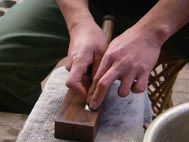
砥石が整ってなくちゃ、刃は研げない。研ぎ味の最終的な決め手は水らしい。不純物の少ない、良く研がれた水が必要らしい。
To be a good sharpener. You have to take care of the condition of a whetstone surface. A most important element for ideal sharpening, is water. You have to get pure, and well-sharpened water.
|




